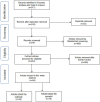Global prevalence of norovirus gastroenteritis after emergence of the GII.4 Sydney 2012 variant: a systematic review and meta-analysis
- PMID: 38993708
- PMCID: PMC11236571
- DOI: 10.3389/fpubh.2024.1373322
Global prevalence of norovirus gastroenteritis after emergence of the GII.4 Sydney 2012 variant: a systematic review and meta-analysis
Abstract
Introduction: Norovirus is widely recognized as a leading cause of both sporadic cases and outbreaks of acute gastroenteritis (AGE) across all age groups. The GII.4 Sydney 2012 variant has consistently prevailed since 2012, distinguishing itself from other variants that typically circulate for a period of 2-4 years.
Objective: This review aims to systematically summarize the prevalence of norovirus gastroenteritis following emergence of the GII.4 Sydney 2012 variant.
Methods: Data were collected from PubMed, Embase, Web of Science, and Cochrane databases spanning the period between January 2012 and August 2022. A meta-analysis was conducted to investigate the global prevalence and distribution patterns of norovirus gastroenteritis from 2012 to 2022.
Results: The global pooled prevalence of norovirus gastroenteritis was determined to be 19.04% (16.66-21.42%) based on a comprehensive analysis of 70 studies, which included a total of 85,798 sporadic cases with acute gastroenteritis and identified 15,089 positive cases for norovirus. The prevalence rate is higher in winter than other seasons, and there are great differences among countries and age groups. The pooled attack rate of norovirus infection is estimated to be 36.89% (95% CI, 36.24-37.55%), based on a sample of 6,992 individuals who tested positive for norovirus out of a total population of 17,958 individuals exposed during outbreak events.
Conclusion: The global prevalence of norovirus gastroenteritis is always high, necessitating an increased emphasis on prevention and control strategies with vaccine development for this infectious disease, particularly among the children under 5 years old and the geriatric population (individuals over 60 years old).
Keywords: gastroenteritis; genotype; meta-analysis; norovirus; prevalence.
Copyright © 2024 Zhang, Hao, Di, Chuizhao, Jinsong, Guisen, Hui and Zhaojun.
Conflict of interest statement
XD was employed by Chengdu Kanghua Biological Products Co., Ltd. The remaining authors declare that the research was conducted in the absence of any commercial or financial relationships that could be construed as a potential conflict of interest.
Figures




Similar articles
-
Molecular epidemiology of norovirus GII.4 variants in children under 5 years with sporadic acute gastroenteritis in South Korea during 2006-2013.J Clin Virol. 2014 Nov;61(3):340-4. doi: 10.1016/j.jcv.2014.08.018. Epub 2014 Sep 1. J Clin Virol. 2014. PMID: 25223918
-
Increased norovirus activity was associated with a novel norovirus GII.17 variant in Beijing, China during winter 2014-2015.BMC Infect Dis. 2015 Dec 18;15:574. doi: 10.1186/s12879-015-1315-z. BMC Infect Dis. 2015. PMID: 26678989 Free PMC article.
-
Molecular epidemiology and genetic diversity of norovirus infection in children hospitalized with acute gastroenteritis in East Java, Indonesia in 2015-2019.Infect Genet Evol. 2021 Mar;88:104703. doi: 10.1016/j.meegid.2020.104703. Epub 2021 Jan 2. Infect Genet Evol. 2021. PMID: 33401005
-
Prevalence and Etiological Characteristics of Norovirus Infection in China: A Systematic Review and Meta-Analysis.Viruses. 2023 Jun 7;15(6):1336. doi: 10.3390/v15061336. Viruses. 2023. PMID: 37376635 Free PMC article.
-
Norovirus Infections and Disease in Lower-MiddleandLow-Income Countries, 1997⁻2018.Viruses. 2019 Apr 10;11(4):341. doi: 10.3390/v11040341. Viruses. 2019. PMID: 30974898 Free PMC article. Review.
Cited by
-
Prevalence and associated factors of norovirus infections among patients with diarrhea in the Amhara national regional state, Ethiopia.BMC Infect Dis. 2024 Sep 27;24(1):1053. doi: 10.1186/s12879-024-09988-5. BMC Infect Dis. 2024. PMID: 39333942 Free PMC article.
-
Virus Association with Bacteria and Bacterial Cell Components Enhance Virus Infectivity.Food Environ Virol. 2025 Jan 9;17(1):15. doi: 10.1007/s12560-025-09633-7. Food Environ Virol. 2025. PMID: 39789292 Free PMC article.
-
Machine Learning and Imputation to Characterize Human Norovirus Genotype Susceptibility to Sodium Hypochlorite.Food Environ Virol. 2024 Dec;16(4):492-505. doi: 10.1007/s12560-024-09613-3. Epub 2024 Sep 11. Food Environ Virol. 2024. PMID: 39259473 Free PMC article.
-
Increased circulation of GII.17 noroviruses, six European countries and the United States, 2023 to 2024.Euro Surveill. 2024 Sep;29(39):2400625. doi: 10.2807/1560-7917.ES.2024.29.39.2400625. Euro Surveill. 2024. PMID: 39328162 Free PMC article.
-
Vaccinia Virus Vector Bivalent Norovirus Vaccine.Viruses. 2025 Feb 9;17(2):237. doi: 10.3390/v17020237. Viruses. 2025. PMID: 40006992 Free PMC article.
References
-
- Tohma K, Lepore CJ, Martinez M, Degiuseppe JI, Khamrin P, Saito M, et al. . Genome-wide analyses of human noroviruses provide insights on evolutionary dynamics and evidence of coexisting viral populations evolving under recombination constraints. PLoS Pathog. (2021) 17:e1009744. doi: 10.1371/journal.ppat.1009744, PMID: - DOI - PMC - PubMed
Publication types
MeSH terms
LinkOut - more resources
Full Text Sources
Medical

